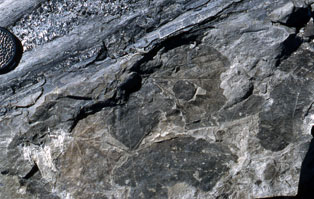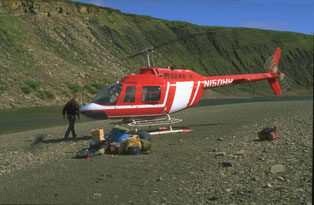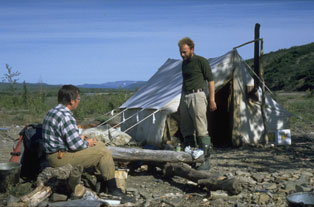About this website
| Background | Navigation | Collections | Photography | Acknowledgements | Authors |
|---|
This interactive illustrated catalogue of Cretaceous and Paleogene Arctic plant fossils is the outcome of a project supported by Grant/Cooperative Agreement Number
G10AP00134
from the United States Geological Survey and administered through the University of Oxford, UK.
It builds on, and incorporates, research conducted under an earlier United States Geological Survey Contract Number
14-08-0001-19175
administered through Imperial College, London.
Background
The richness of the Cretaceous and Paleogene floras of Alaska and Northeastern Russia is almost overwhelming. It has taken more than three decades of study to arrive at the point where the collections made so far can be organized and presented in something like a coherent manner. The volume of material is so great that publication as a conventional print monograph is impossible. As will be apparent from close examination of this catalogue the work is as yet far from complete, but with the development of web technologies it has at least become possible to put this material in the public domain, much of it for the first time. This is not a database in the sense that it is not searchable, but rather it is an 'interactive illustrated catalogue' documenting an extraordinary record of the 'Lost World of the Arctic': the extinct Arctic forest ecosystem of the Cretaceous and early Paleogene. In the late 1970s, funding from the U.S. Geological Survey (USGS) and the Office of the National Petroleum Reserves in Alaska enabled one of us (Bob Spicer) to explore the Alaska Peninsula and northern Alaska by helicopter. The brief was to look for plant fossil assemblages, specifically leaves, to help understand the relationships and relative ages of the rocks that contained them. At that time, preliminary geologic mapping of the area had been completed, but logistical constraints during the 1940s and 50s meant that collections of plant leaves, wood, and reproductive organs (collectively termed here megafossils, as distinct from fossil pollen and spores, which are microfossils) were few. Microfossils have the advantage that small samples of rock contain large numbers of fossils, but the disadvantage is that they can be eroded from one rock and incorporated into another. This reworking can cause problems in, for example, understanding the relative ages of different rock formations. Megafossils are much less likely to be reworked and offer greater reliability in relative age determinations. The use of helicopters allowed some representative collections of megafossils to be made on a regional basis, but weight limitations determined that these collections remain small. Over the same period, Spicer was also funded by the USGS to make extensive megafossil collections in a detailed stratigraphic and depositional environment context from the Yukon-Koyukuk Basin, west-central Alaska. The result of this work was a USGS Open File Report 14-08-0001-19175 produced in 1983. Prior to that, in the 1960s, C.J. Smiley of the University of Idaho, together with a series of field assistants and supported by the Navy and the Arctic Research Laboratory, rafted down many of the major rivers on the North Slope and made extensive collections of plant megafossils. Summary overviews of his floral stratigraphic zones were published, but with few illustrations, and many of his comparisons with Russian floras had to be based on often poorly illustrated Russian literature. Due to Cold War constraints direct access to the Russian specimens was impossible. In 1980, Smiley welcomed Spicer to study these collections and helped Spicer extend his knowledge of the Cretaceous flora of northern Alaska. Tragically Smiley died without illustrations of his collections ever being published in any comprehensive form. This catalogue makes available in the public domain, for the first time, almost his entire collection. Beginning in the 1970s research into the processes of the formation of plant fossil assemblages (taphonomy) highlighted the need to study such assemblages in the field in a detailed sedimentological context (Spicer, 1981; Ferguson, 1985; Spicer 1989). At the suggestion of C.G. (Gil) Mull of the State of Alaska Division of Geological and Geophysical Surveys, Bob Spicer and Judy Parrish embarked on a series of rafting trips, similar to those pioneered by Smiley, down the Upper Colville River between the Etivluk River and Umiat and subsequently along the Lower Colville River between Umiat and Ocean Point. The field work floats of Spicer and Parrish were conducted in the summers of 1985, 1986, and 1989. On these trips, they made extensive collections of Cretaceous leaves, wood, cones, fruits, and seeds, together with many samples of pollen and coal. All this material was collected, wherever possible, in the context of observations on the sediments and in some cases measured sections. From analysis of the sedimentology, the taphonomic processes giving rise to each assemblage were deduced and this in turn enabled them to reconstruct, with a high level of confidence, the ancient living communities and the changing regional vegetation and climate throughout the Late Cretaceous. In 1992, following the end of the Soviet Union, Bob Spicer and Alexei Herman met at a conference in Paris. Herman, in parallel to Spicer in Alaska, had been studying the Cretaceous floras of northeastern Russia. They were familiar with each other's interests and arranged to work together. Initially through funding from Oxford University Earth Sciences Department, and subsequently the Royal Society of London and the British Council, a series of exchange visits were started that led to what is now 24 years of continuous collaboration and the publication of over 40 peer-reviewed papers on the Arctic Cretaceous floras. In 1996 Spicer and Herman floated the Kukpowruk River, Alaska, followed in 1997 by fieldwork along the Grebenka River in northeastern Russia with Anders Ahlberg (Lund University, Sweden), Allistair Rees (then at The Open University, UK) and Misha Reikevitch (then at the Geological Institute in Magadan). Spicer returned to Alaska in 1998 and floated the Kokolik River with Andrew Spicer. More recently Herman and Spicer returned to Alaska in 2001 with Anders Ahlberg, and 2005 with Anders Alberg, Maria Moiseeva and David Jolly (Aberdeen University, UK) to collect from the Sagwon River Section. None of this work could have been attempted without the pioneering work of numerous previous investigators on both sides of the Bering Straits. For a more detailed overview of those in Russia click here and for those in Alaska click here. |
 |
||||||
 |
|||||||
 |
|||||||
 |
|||||||
 |
|||||||
 |
|||||||
 |
|||||||
